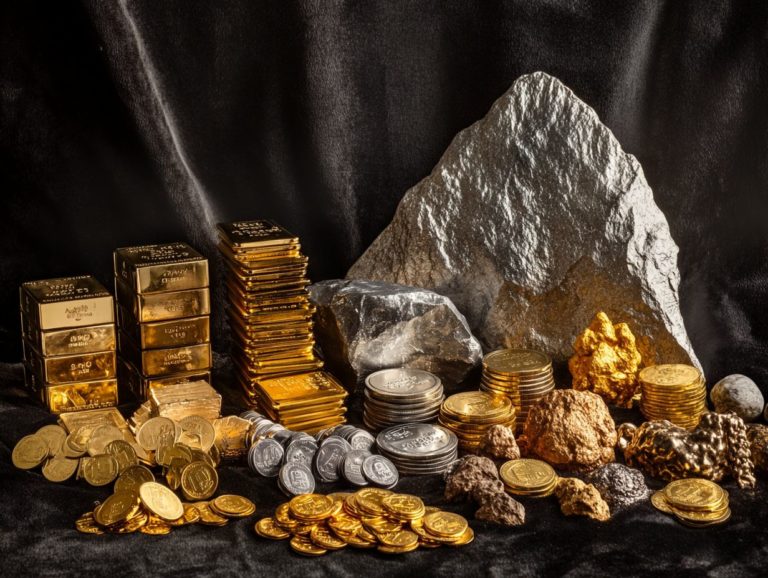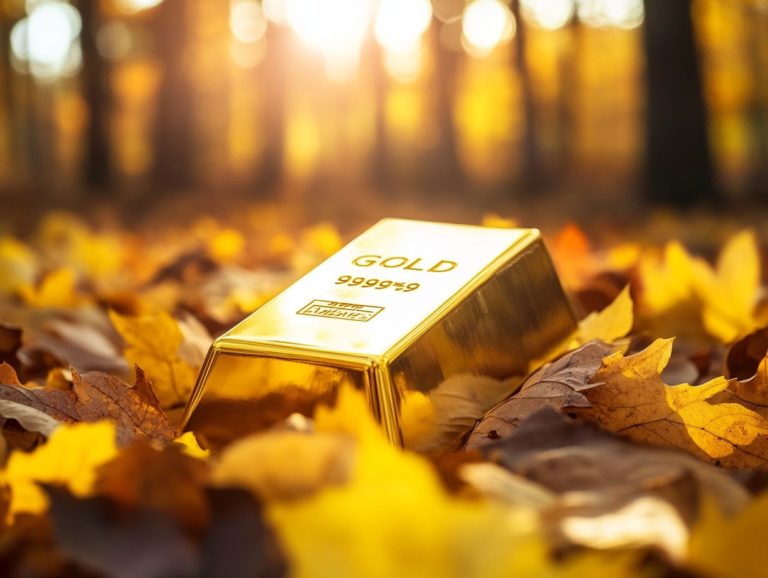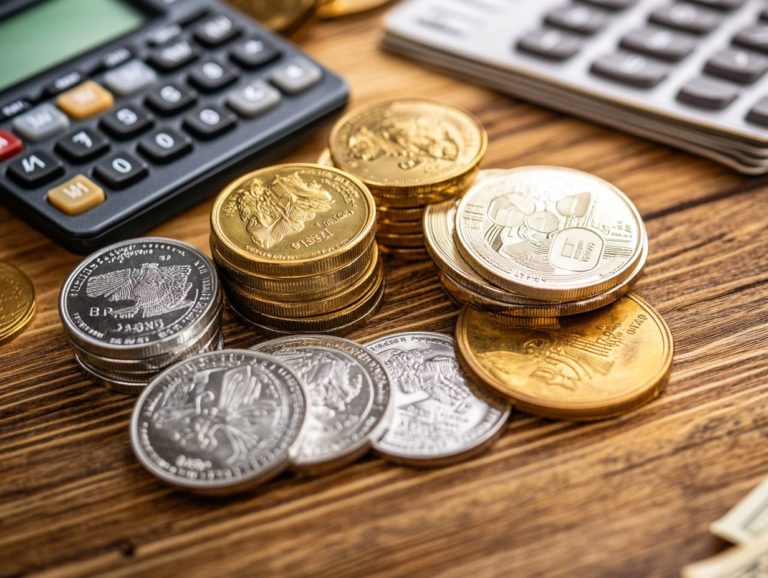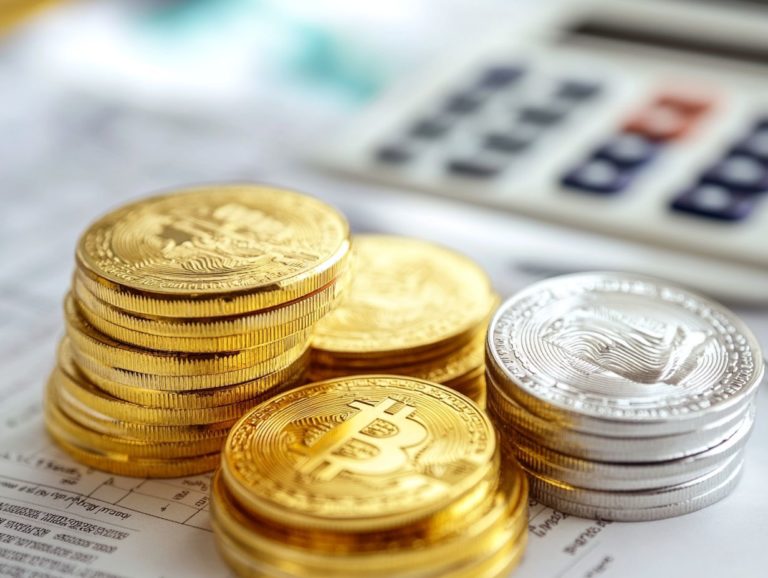The Role of Precious Metals in Global Trade
Precious metals have always intrigued people. They aren’t just valuable; they also symbolize wealth and power throughout history.
From gold and silver to platinum and palladium, these metals hold a vital place in various industries and economies across the globe. Curious about how these metals affect your life? Let s dive in!
This article invites you to explore the rich history of precious metals in trade, their significance in ancient civilizations, and the current dynamics shaping global markets. You ll delve into their diverse applications in technology and jewelry. We ll also discuss challenges and controversies surrounding their extraction and trade.
Join us on this journey to discover the multifaceted world of precious metals and their enduring influence on your life.
Contents
- Key Takeaways:
- Overview of Precious Metals
- The History of Precious Metals in Trade
- Current Global Trade of Precious Metals
- Uses of Precious Metals in Various Industries
- The Economic Impact of Precious Metals
- Challenges and Controversies Surrounding Precious Metals Trade
- Frequently Asked Questions
- What are precious metals?
- What is the role of precious metals in global trade?
- Why are precious metals considered valuable in global trade?
- How are precious metals traded in global markets?
- What impact do precious metals have on the global economy?
- What future developments can we expect for the role of precious metals in global trade?
Key Takeaways:

1. Precious metals have a long history in global trade, dating back to ancient civilizations and continuing to play a significant role in today’s economy.
2. These metals are used in various industries, including technology, jewelry, and finance. Their value directly impacts currency and markets.
3. The trade of precious metals also faces challenges and controversies, such as environmental and ethical concerns. These must be addressed for sustainable global trade.
Overview of Precious Metals
Precious metals like gold, silver, platinum, and palladium have long stood as pillars of wealth preservation and smart investment choices. They carry intrinsic value, and their distinctive properties make them vital across various asset classes.
As assets that protect your money during hard times, they typically shine during economic uncertainty. They offer a shield against inflation and market fluctuations. Financial advisors frequently suggest incorporating these metals into your investment portfolio to diversify against unpredictable market conditions and geopolitical tensions.
Definition and Types
Precious metals are naturally occurring metallic elements that hold significant economic value. Gold, silver, platinum, and palladium stand out as the most prominent.
Gold is often regarded as a safe haven during economic uncertainty, appealing to investors seeking to preserve their wealth. Its outstanding conductivity makes it popular in coinage and high-end electronics.
Silver offers a blend of industrial utility think solar panels and medical devices and aesthetic charm, making it a favorite in jewelry design.
Platinum shines in the automotive industry, particularly in catalytic converters, due to its remarkable ability to endure extreme conditions. Meanwhile, palladium has emerged as a crucial player in the electronics sector in recent years.
Together, these metals not only enhance financial portfolios but also drive technological innovation forward.
The History of Precious Metals in Trade
The history of precious metals in trade stretches back to ancient civilizations. Gold and silver were esteemed not merely for their aesthetic allure but also as valuable mediums of exchange.
These metals played a crucial role in shaping early economic systems and facilitating trade. They established wealth disparities and became woven into the fabric of various cultural practices. Ultimately, they laid the groundwork for today s financial markets and investment strategies.
Role in Ancient Civilizations
In ancient civilizations, gold and silver were not merely metals; they were the lifeblood of trade and commerce, as well as symbols of status that shaped societal dynamics across various regions.
These precious metals often found their way into religious artifacts, exquisite jewelry, and lavish tributes to rulers, deeply embedding their significance in cultural practices.
Take Mesopotamia, for example. Silver was a staple in exchanges, establishing standardized weights that underpinned the economy, while gold graced the temples devoted to deities, reflecting a sense of divine glory.
In ancient Egypt, gold transcended mere wealth; it served as a vital element in funerary practices, symbolizing eternal life for pharaohs.
The Incas held gold in high esteem as a representation of the sun, crafting intricate items that mirrored their societal values.
Meanwhile, in ancient China, silver facilitated trade along the Silk Road, enhancing diplomatic relations and showcasing the interconnectedness of cultures.
Throughout history, these precious metals have not just facilitated commerce; they have acted as universal tokens of cultural expression and social hierarchy, weaving a rich tapestry of human civilization.
Current Global Trade of Precious Metals

Today, the global trade of precious metals is complex. It involves production, consumption, and pricing strategies shaped by market dynamics and international trade policies.
Nations like the United States and China hold considerable sway in the realms of gold, silver, platinum, and palladium production and consumption. Their activities not only influence global economic indicators but also significantly impact investor sentiment across the board.
Top Producing and Consuming Countries
The leading countries in precious metals production are typically those rich in natural resources, like China and Australia, which take the lead in gold and silver output. Following them are South Africa and Russia, prominent players in platinum and palladium production.
These nations powerfully shape market conditions, making them crucial players to watch! Along with their strong mining sectors, the economic policies in these regions think trade tariffs and export regulations are vital in shaping the dynamics of global supply and demand.
For instance, when China’s economic growth fluctuates, it can have a dramatic impact on global gold consumption, driven by the burgeoning demand from its large middle class for jewelry and investment purposes.
Labor disputes in South Africa have historically affected platinum production, causing ripples that reverberate through market prices. As an investor, you need to keep careful attention on these political and economic issues, recognizing that any shifts in policy or production levels could present substantial opportunities or risks for your investment portfolio.
Uses of Precious Metals in Various Industries
Precious metals find their way into a multitude of industries, from cutting-edge technology to exquisite jewelry and automotive applications, highlighting their remarkable versatility and intrinsic value.
Their distinctive properties render them critical in high-tech devices, luxurious goods, and various industrial processes, solidifying their importance within global economic frameworks.
Technology, Jewelry, and More
Precious metals play a pivotal role in technology, with gold and silver at the forefront, enhancing conductivity and efficiency in electronics.
In the jewelry market, these metals are not just valued for their practicality; their aesthetic allure and durability create significant demand and lucrative investment opportunities.
In the realm of industry, platinum and palladium stand out as essential components, particularly in catalytic converters that help mitigate harmful vehicle emissions, underscoring their environmental impact.
Each metal offers its own unique advantages that amplify its appeal; for example, gold resists corrosion and tarnish, while silver excels in thermal and electrical conductivity.
As society advances and technology progresses, the persistent demand across various sectors shapes market dynamics. Investors often view these metals as stable assets, particularly in times of economic uncertainty, which in turn drives up their value and reinforces their status as a hedge against inflation. Stay informed and ready to seize opportunities in this ever-evolving market!
The Economic Impact of Precious Metals
The economic impact of precious metals goes well beyond mere market prices; they influence currency valuation, play an important role in financial markets, and act as effective hedges against inflation.
By offering both capital appreciation and wealth protection, these metals are essential for maintaining economic stability, particularly during periods of financial turbulence.
Influence on Currency and Markets

Precious metals have a significant influence over currency fluctuations and financial markets, often serving as a reliable indicator of economic health. Their performance can signal effective inflation protection, making them essential assets for those who aim to navigate the complexities of market volatility.
Gold and silver, in particular, have historically shown a strong inverse relationship with government-issued currencies, especially during periods of economic uncertainty. As inflation rises, their intrinsic value typically follows suit, leading investors to seek refuge in these tangible assets.
Historical data from previous economic downturns illustrates that while currency values may depreciate, precious metals often experience a rally, reinforcing their role as a hedge.
Understanding these trends arms you with valuable insights into the broader economic landscape, enabling informed investment decisions when confronted with inflationary pressures.
Challenges and Controversies Surrounding Precious Metals Trade
The trade of precious metals presents a variety of challenges and controversies. From environmental concerns tied to mining practices to ethical dilemmas surrounding labor and trade disputes, the landscape of investment options becomes increasingly complex.
These factors invite meaningful discussions about sustainability and responsible sourcing, elevating your awareness and decision-making in this intricate market.
Environmental and Ethical Concerns
Concerns surrounding precious metals primarily arise from mining practices that can lead to ecological degradation and social upheaval. As communities face issues like water contamination and the displacement of local populations, the ethical implications become more pronounced.
Furthermore, regulatory challenges complicate the investment landscape, urging you to consider the sustainability of your investment portfolio.
These issues not only impact community well-being but also directly influence the longevity and profitability of your investments.
With public awareness of environmentally responsible sourcing on the rise, many investors are reevaluating their strategies. This shift has led to a heightened emphasis on transparency and ethical sourcing standards, which shape investment decisions and the overall market dynamics.
Frequently Asked Questions
What are precious metals?
Precious metals are unique and valuable treasures that occur naturally and have high economic value. They are used in various industries, including jewelry, technology, and investment. Examples include gold, silver, platinum, and palladium.
What is the role of precious metals in global trade?

Precious metals play a significant role in global trade as they are used as a form of currency, a store of value, and a means of investment. Understanding their importance is crucial, as they are widely traded on international markets and can aid in diversification, making them an important commodity in the global economy.
Why are precious metals considered valuable in global trade?
Precious metals are valued in global trade due to their scarcity and high demand, along with intrinsic properties like durability, malleability, and conductivity. They have served as currency and a stable store of value for centuries, making them reliable assets in the trading world.
How are precious metals traded in global markets?
Precious metals are primarily traded through futures contracts. These contracts let buyers and sellers set a price for a specific amount of metal on a future date.
They are also available through exchange-traded funds (ETFs), mutual funds, and by purchasing the metal directly.
What impact do precious metals have on the global economy?
Precious metals have a multifaceted impact on the global economy. They often become a go-to investment during uncertain times and inflation.
Price fluctuations can also significantly affect economies that rely heavily on metal production and export.
What future developments can we expect for the role of precious metals in global trade?
Digital currencies and technology advancements may change the role of precious metals in trade. Yet, these metals are likely to maintain their value and significance, especially during economic uncertainty.





